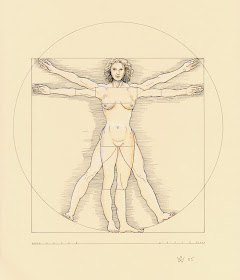

No doubt you are familiar with the 1st image, even if you don't know its formal name. This version of Vitruvian Man was drawn by Renaissance artist Leonardo da Vinci c. 1487. The name refers to ancient Roman architect Marcus Vitruvius Pollio (1st c. B.C.), who described the human figure as the main source of proportion in classical architecture. Some of the proportions set forth in his text are as follows:
- the length of a man's outspread arms is equal to his height
- the distance from the top of the head to the bottom of the chin is 1/8th of a man's height
- the maximum width of the shoulders is 1/4th of a man's height
- the length of the hand is 1/10th of a man's height
- the distance from the bottom of the chin to the nose is 1/3rd of the length of the head
- the length of the ear is 1/3rd of the length of the face
- the length of a man's foot is 1/6th of his height
But were you aware that there are a number of Vitruvian women? As a modern response to the idea that man is the measure of all things, a woman has been drawn in his place. Pictured (2nd image) is "Sex Change for Vitruvian Man" (2005) by contemporary Australian artist Susan Dorothea White. Also of note is "Vitruvian Woman" (1989) by contemporary American artist Nat Krate. There have also been a performance piece (1980) and a video installation (2009) intent on feminizing the iconic image of the Vitruvian Man - without giving him a "wife," as was done with the Visible Man.
No comments:
Post a Comment
You may add your comments here.